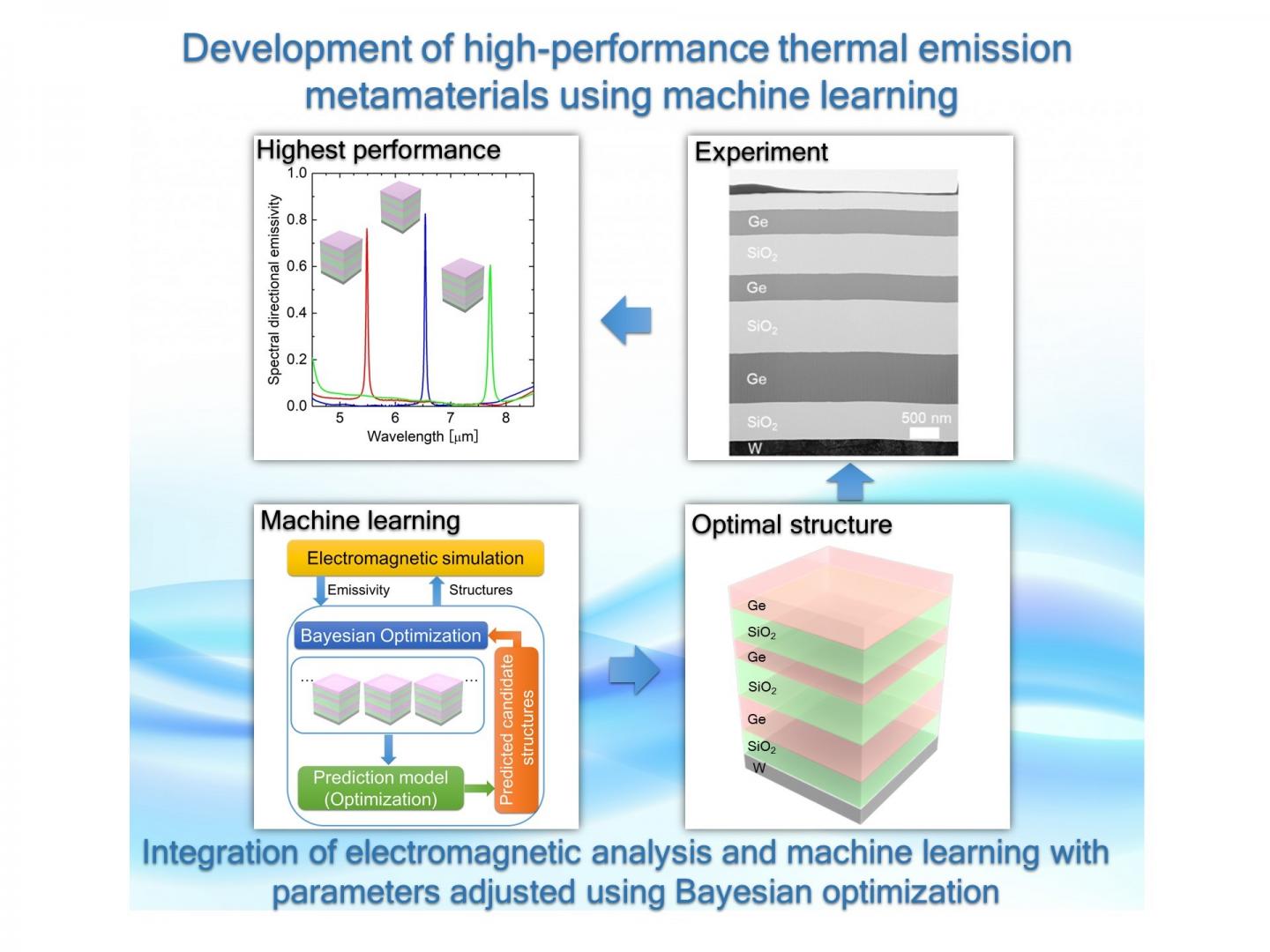Selection of an optimum structure from approximately eight billion candidates may make society more energy efficient

Credit: NIMS
NIMS, the University of Tokyo, Niigata University and RIKEN jointly designed a multilayered metamaterial that realizes ultra-narrowband wavelength-selective thermal emission by combining the machine learning (Bayesian optimization) and thermal emission properties calculations (electromagnetic calculation). The joint team then experimentally fabricated the designed metamaterial and verified the performance. These results may facilitate the development of highly efficient energy devices.
Thermal radiation, a phenomenon that an object emits heat as electromagnetic waves, is potentially applicable to a variety of energy devices, such as wavelength-selective heaters, infrared sensors and thermophotovoltaic generators. Highly efficient thermal emitters need to exhibit emission spectrum with narrow bands in practically usable wavelength range.. The development of such efficient thermal emitters has been targeted by many researches using metamaterials that can manipulate electromagnetic waves. However, most of them have taken an approach of characterizing the material structures selected empirically. , it has been difficult to identify the optimum structure from a vast number of candidates.
The joint research group developed a method of designing metamaterial structures with optimum thermal radiation performance using a combination of machine learning and the calculation of thermal emission properties. This project focused on easy-to-fabricate multilayered metamaterial structures composed of three types of materials in 18 layers of varying thickness. Application of this method to about eight billion candidate structures led to the prediction that a nanostructure composed of non-periodically arranged semiconductor and dielectric materials would have superior thermal radiation performance, which was contrary to the conventional knowledge. Then the research group actually fabricated the metamaterial structure and measured its thermal emission spectrum, and consequently demonstrated an extremely narrow thermal emission band. Measured in terms of the Q-factor (a parameter used to measure the width of thermal emission spectral bands), the newly designed nanostructure produced a Q-factor close to 200, when 100 had been considered the upper limit for conventional materials?an exceptionally narrow thermal emission spectral band.
This research demonstrated the effectiveness of machine learning in developing highly efficient thermal emission metamaterials. The development of metamaterials with desirable thermal emission spectra is expected to facilitate more efficient energy use throughout the society. Because the nanostructure design method developed is applicable to all kinds of materials, it may serve as an effective tool for the design of high-performance materials in the future.
###
This research project was carried out by a research group led by Junichiro Shiomi (Professor, Department of Mechanical Engineering, The University of Tokyo) Atsushi Sakurai (Associated Professor, Department of Mechanical and Production Engineering, Niigata University) and Koji Tsuda (Professor, Graduate School of Frontier Sciences, The University of Tokyo). The part of this project conducted at the CMI2 (Center for Materials Research by Information Integration) was supported by the JST “Materials Research by Information Integration” Initiative (MI2I), while the remainder of this project, conducted at the RIKEN Center for Advanced Intelligence Project (AIP), was supported by funding from MEXT.
This study was published in ACS Central Science, an online U.S. journal, as an “ASAP article” on January 22, 2019, Eastern Standard Time.
###
Contacts
(Regarding this research)
Junichiro Shiomi
Professor, Department of Mechanical Engineering, The University of Tokyo;
Special Researcher, Center for Materials Research by Information Integration (CMI2), National Institute for Materials Science;
Visiting Scientist, RIKEN Center for Advanced Intelligence Project
7-3-1 Hongo, Bunkyo-ku, Tokyo 113-8656, Japan
Tel: +81-3-5841-6283, Fax: +81-3-5841-0440
Email: [email protected]
Atsushi Sakurai
Associate Professor, Department of Mechanical and Production Engineering, Niigata University;
Special Researcher, Center for Materials Research by Information Integration (CMI2), National Institute for Materials Science
2-8050 Ikarashi, Nishi-ku, Niigata 950-2181, Japan
Tel: +81-25-262-7004, Fax: +81-25-262-7004
Email: [email protected]
(Regarding JST projects)
COI Group
Department of Innovation Platform
Japan Science and Technology Agency
K’s Gobancho, 7 Gobancho, Chiyoda-ku, Tokyo 102-8666, Japan
Tel: +81-3-6267-4752, Fax: +81-3-5214-8496
Email: [email protected]
(For general inquiries)
Public Relations Office
National Institute for Materials Sciences
Tel: +81-29-859-2026
Fax: +81-29-859-2017
E-Mail: pressrelease=ml.nims.go.jp
(Please change “=” to “@”)
Public Relations Office
School of Engineering
The University of Tokyo
7-3-1 Hongo, Bunkyo-ku, Tokyo 113-8656, Japan
Tel: +81-3-5841-1790, Fax: +81-3-5841-0529
Email: [email protected]
Public Relations Office
Graduate School of Frontier Sciences
The University of Tokyo
Tel: +81-4-7136-5450
Email: [email protected]
Public Relations Office
Niigata University
2-8050 Ikarashi, Nishi-ku, Niigata 950-2181, Japan
Tel: +81-25-262-7000, Fax: +81-25-262-6539
E-mail: [email protected]
Public Relations Office
RIKEN
Tel: +81-48-467-9272, Fax: +81-48-462-4715
Email: [email protected]
Public Relations Division
Japan Science and Technology Agency
5-3 Yonbancho, Chiyoda-ku, Tokyo 102-8666, Japan
Tel: +81-3-5214-8404, Fax: +81-3-5214-8432
Email: [email protected]
Media Contact
Yasufumi Nakamichi
[email protected]
Original Source
https:/
Related Journal Article
http://dx.




